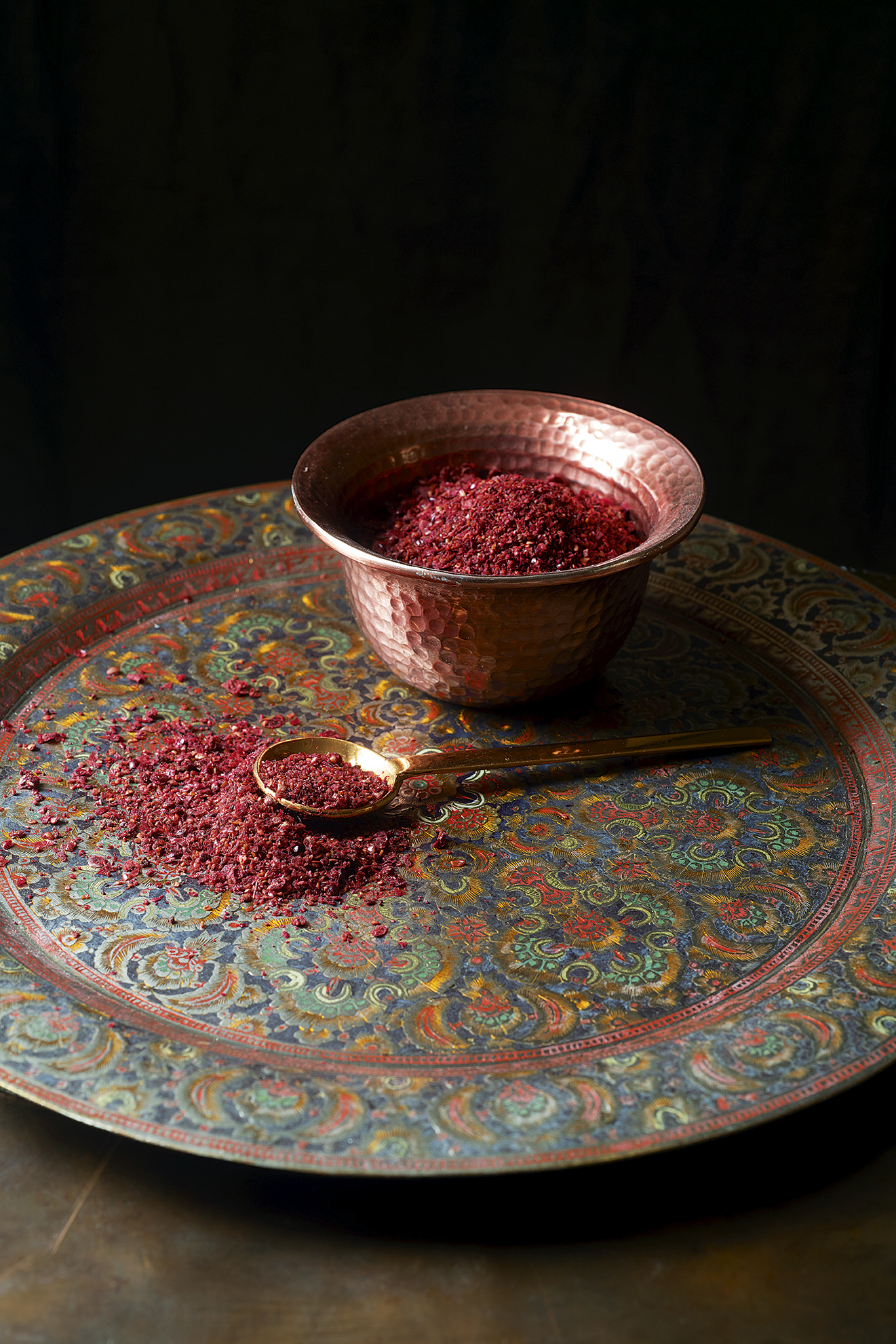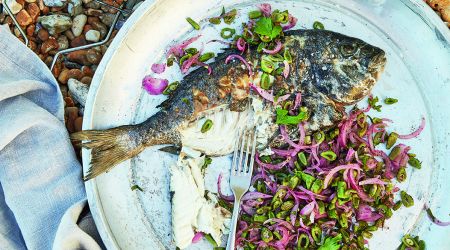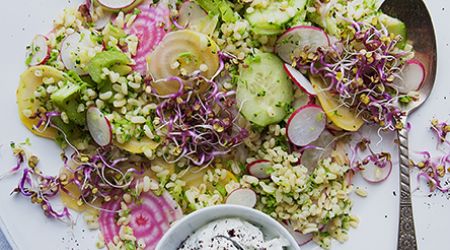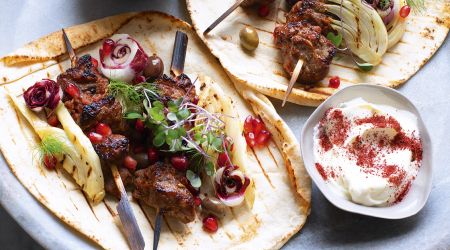Sumac
Appreciated for its citrus notes, the seeds of this fruit are pounded into fine powder ready to sprinkle for a pleasant sourness. Clarissa Hyman explores its widespread use and Linda Tubby shares her tangy recipes
WHAT IS IT?
Try not to be put off by the fact sumac belongs to the same tribe as poison ivy: the genus Rhus, as in many closely related families, has both good and toxic members. The one that concerns us here is R. Coriaria, also known as the elm-leaved or Sicilian sumac. Strictly speaking, sumac isn’t exactly a spice; it comes from the fruit of the sumac flower.
The ground berries have long served as an important souring agent in Middle Eastern cooking, especially in Lebanon, where it was commonly used in place of lemon or vinegar especially in times when lemons were out of season, or rare and expensive. Even today in Western cooking, the spice remains relatively unknown, under-used and unappreciated despite the popularity of restaurants with Israeli and Middle Eastern influences such as Ottolenghi and Honey and Co.
THE ORIGINS
Clumps of sumac grow wild in countries across the eastern Mediterranean and Middle East and many varieties are also found across subtropical parts of Africa and North America.
It was known to the Romans and mentioned in medieval Arab cookbooks. The best quality fruit are picked in the mountains once ripe, when the hairy berries flush dark red to purple. After harvesting, they are sun-dried on the branch before the seeds are pounded into a medium-fine, dark, rust-red powder.
TASTING NOTES
Ground sumac has a sour, pleasantly astringent and fruity taste without being pungent or overpowering. It’s such a versatile spice that it’s hard to go wrong when using it. If in doubt, try adding it as you would lemon or lime. Cooking can reduce its flavour somewhat but it can be revived simply by sprinkling the finished dish with a little more.
The whole berries keep for months in an airtight container but the ground spice should be bought in small quantities in sealed jars or packages, as it tends to quickly lose colour and flavour.
Sumac can give a citrus lift to most dishes from pilaf to kibbeh, flatbreads to sautéed chicken, falafel wraps to baked feta.
It is also one of the spices in the Arabic spice mix za’atar, which also includes sesame seeds, salt and thyme. In some restaurants and kebab houses in the Middle East, sumac may appear on the table as one of the condiments to sprinkle over soups and chargrilled meats.
In Iran, a bowlful is always served alongside chelo kebab teamed rice and meat) to dust over your meal before eating.
ANY BENEFITS?
The berries are high in antioxidants, making them even more highly rated in this respect than cinnamon and oregano. We know sumac was used in ancient times as a tonic, antiseptic and astringent. In Lebanon, a refreshing and medicinal cold drink is made from steeping the berries in cold water before the juice is squeezed out. Spice specialist Tom Hobart notes this is said to be recommended for ‘Beirut belly’.
In North America, sumac was historically used by Native Americans in healing drinks and in smoking mixtures for ceremonial purposes. The spice is also said to help lower blood sugar levels, and the juice is high in vitamin C.
QUICK TIPS
Sprinkle over salads, fried eggs, hummus or cold cooked dishes such as aubergine salad, add to marinades for fish or poultry, or give a tangy edge to your salad dressings and stews. You can also spike yoghurt or labneh with sumac and serve it as a dip for both grilled and fried foods.
Try roasting parboiled potato wedges with sea salt and sumac and serving sprinkled with chopped parsley and a garlic dip. Make a refreshing salad with chopped cucumbers, feta and mint dressed in olive oil, red wine vinegar, sumac, salt and pepper. And for a fast brunch with a glamorous edge serve creamy sumac- scrambled eggs with smoked salmon and diced cooked beetroot.
Other ways to experiment include tossing some sumac with a little sea salt to sprinkle over popcorn to add an intriguing salt ’n’ pepper dimension to your movie-watching. If you’re feeling more adventurous, try using it in desserts such as a bittersweet chocolate ganache or in cocktails – start with a sumac Bloody Mary and see if you like the addition.
HOW TO SHOWCASE IT
Lahm bi Ajeen is a thin, finger-lickin’ Arab-style pizza filled with spicy tomato and minced lamb, where sumac takes a starring role. Either eaten as a snack or a meal, they’re usually served with chopped parsley, sumac and lemon to squeeze over, and most people like to roll them up to eat in the hand.
Combined with pomegranate syrup, it gives a boost to quickly fried chicken livers and onion along with a sprinkling of pepper, cinnamon and allspice. A famous Palestinian dish, Musakhan, is made from flatbread layered with onion, olive oil, sumac-roasted chicken, almonds and other spices. Another variation roasts chicken with preserved lemons, sumac and spiced yoghurt.
In her extensive compilation of Lebanese cooking, Salma Hage has several interesting suggestions. Some examples include a lovely dish of grilled halloumi cheese with sumac, walnuts, pears and cos lettuce; pan-fried squid with chilli and sumac; filo rolls with sweet potato, sumac, honey and coriander; and a vibrant dish of salmon with sumac crust, coriander and ginger dressing.
Other, more contemporary, Western-based ideas include slow- cooked pork knuckle with harissa and peppers drizzled witha sumac dressing; lamb shanks with mint butter, yoghurt and sumac; and ricotta and vegetable pizza, all from Matt Tebbutt. And the flavouring is given an Antipodean spin in a dish of hoisin and plum-glazed ham with lemon potato salad from Bill Granger.
ANYTHING ELSE?
Note that some brands may mix sumac with salt to bulk it up, so keep an eye on the seasoning of the dish that you’re making.
It’s been used to visually enhance dishes too: one ancient Arabic dish, Fakhtiyyah, gets its name from the Persian word for ring-dove, presumably due to the pale purple shade produced by the combination of sumac and yoghurt.
A number of shrubs found in North America include the Scarlet sumac (R. Glabra) which has large, dense clusters of hairy red berries; but some, like those with white berries and/or smooth, hairless fruits should be avoided as they’re likely to be poisonous. As with all plants with toxicity in the family, it’s best to stick with those gathered for culinary use by people in the know.

Recipes
Get Premium access to all the latest content online
Subscribe and view full print editions online... Subscribe









